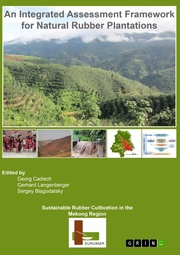Detailansicht
Sustainable Rubber Cultivation in the Mekong Region (SURUMER)
An Integrated Assessment Framework for Natural Rubber Plantations
ISBN/EAN: 9783668830516
Umbreit-Nr.: 5921527
Sprache:
Englisch
Umfang: 172 S., 24 farbige Illustr.
Format in cm: 1.3 x 21 x 14.8
Einband:
kartoniertes Buch
Erschienen am 24.10.2018
Auflage: 1/2018
- Zusatztext
- Research Paper (postgraduate) from the year 2018 in the subject Agrarian Studies, University of Hohenheim (Institute of Agricultural Sciences in the Tropics (Hans-Ruthenberg-Institute) (490), Agronomy in the Tropics and Subtropics (490e)), language: English, abstract: Natural rubber represents a key industrial commodity of modern societies. Often inconspicuous, it is a component of thousands of products making everyday life easier, more comfortable, or safer. The most prominent one is definitely the vehicle tire which consumes about two thirds of the global rubber production of currently more than 12 million tons per year. What makes natural rubber so extraordinary is not a specific property but its combination of properties, which is still unmatched by any type of synthetic rubber. Thus, global development and industrialization led to an increase of over 50% in rubber plantations between the years 2000 and 2015, covering now over 12 million hectares worldwide. Originally a product of the New World, of South America and Amazonia, respectively, the development of a plantation industry in Southeast Asia led to a practically complete shift of the production site. Nowadays, about 97% of the produce is of Old World origin, SE Asia being responsible for 92%. The expansion of rubber plantations went along not only with the replacement of traditional, diverse land-use systems, but also the replacement of large areas of natural forests. In contrast to other tropical planation crops Hevea brasiliensis is mainly cultivated by smallholders. While natural rubber has enhanced the livelihoods in many rural areas, not all farmers have profited to the same degree. Thus, farmers are exposed to the inherent price volatility, and the monoculture-production as well as the expansion of rubber into marginal areas has major impacts on environmental services, such as plant and animal biodiversity, carbon sequestration, greenhouse gas retention, soil sustainability, as well as water quantity and quantity. The objective of the BMBF - funded research project Sustainable Rubber Cultivation in the Mekong Region - SURUMER was thus to analyze the current management practices together with the socio-economic and environmental impacts and develop an integrated assessment framework, allowing decision makers and stakeholders to better understand the potential consequences of management decisions. This publication will pinpoint the projects structure and approach as well as its integrated findings and recommendations towards a more sustainable rubber cultivation in the Mekong Region. The elaboration does not only intend to provide a comprehensive overview on SURUMERs outputs and results, but also acts as the Final Report of the project.
